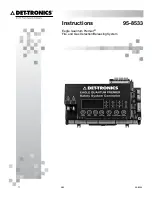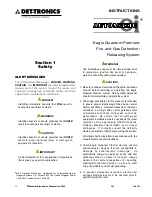
7.1
95-8533
2-1
Section 2
Introduction
SyStem DeScrIptIon
The Eagle Quantum Premier (EQP) system combines
"fire detection and extinguishing agent release" and
"hazardous gas monitoring" in one complete package.
The system is intended for use in hazardous locations
and is designed to meet the requirements of approval
agencies from around the world.
The system consists of a Controller and a number of
addressable microprocessor based field devices.
The Controller coordinates system device
configuration, monitoring, annunciation, and control,
while the field devices communicate their status and
alarm conditions to the Controller.
The EQP controller can be arranged in a redundant
configuration, thereby increasing the availability of the
system. The controllers work in “Master” and “Hot
Standby” mode.
Various combinations of field devices can be
configured as part of the system. The actual selection
depends on the requirements of the application and
the regulations that cover the type of protection
required. See Figure 2-1 for a block diagram of the
Eagle Quantum Premier system.
All field devices are tied into a communication loop
that starts and ends at the Controller. Each device
connected to the communication loop is assigned a
unique identity by setting its address switches. All
other device operation parameters are configured
through Det-Tronics “Safety System Software”. These
selections define the type of device and how it is to
operate. This system configuration data is then
downloaded into the Controller.
A programmed Controller is configured to
automatically download the configuration data into the
individual devices when they first communicate with
the Controller.
In addition to Det-Tronics advanced flame and gas
detectors, Eagle Quantum Premier offers the
capability of incorporating third party fire and gas
protection equipment into the system. These can be
either input or output devices. Typical input devices
include manual fire alarm "call boxes", heat detectors,
and analog combustible or toxic gas measurement
instruments. Typical output equipment includes
solenoids, strobes, and horns. All equipment is
monitored for wiring fault conditions.
For complete system integration, the Controller has
the capability to communicate with other systems
such as PLCs and DCSs. Different communication
protocols are supported, allowing the Controller to
communicate with other systems either directly or
through communication gateways.
note
existing eagle Quantum field devices such as
eQ22xxUV, eQ22xxUVIR and eQ22xxUVHt are
supported by the eagle Quantum Premier system
(not FM Approved).
note
For specific information relating to the SIL 2 rated
eQP system, refer to manual number 95-8599.
CommuniCations Loop
Eagle Quantum Premier utilizes a Det-Tronics
Signaling Line Circuit (SLC), a version of Echelon’s
Local Operation Network (LON) customized
specifically for Eagle Quantum Premier. This network
provides several key advantages:
• ANSI/NFPA Class A, Style 7 performance of SLC
• Peer-to-peer communications
• Short message formats
• Expandability
The Controller utilizes several mechanisms to
continuously check the LON loop for fault conditions,
thereby providing the highest level of reliable
communication.
Every device on the LON loop has the ability to
communicate with the Controller at any time. This is
typically referred to as distributed peer-to-peer
communications. This design allows for immediate
alarm messages to be sent from the field devices to
the Controller.
All messages are kept short in order to maximize
network performance. This minimizes network
bottlenecks.
The Eagle Quantum Premier system is easily modified
to accommodate design changes or plant expansions.
This can involve adding LON sections, repositioning
LON sections, or removing LON sections from the loop.
There are LON communication implementation details
that affect and limit how the LON loop is changed.
Only devices that have been approved for use with
Eagle Quantum Premier can be connected up to the
LON. All approved devices have been tested and
certified to operate properly on the LON.
Summary of Contents for DET-TRONICS 95-8533
Page 128: ...7 1 95 8533 A 4 Figure A 1 System Drawing 007545 001 ...
Page 129: ...95 8533 A 5 7 1 Figure A 2 System Drawing 007545 001 ...
Page 131: ...95 8533 7 1 B 2 Figure B 1 Drawing 007546 001 ...
Page 132: ...95 8533 7 1 B 3 Figure B 2 Drawing 007546 001 ...
Page 134: ...95 8533 7 1 C 2 Figure C 1 Drawing 007547 001 ...
Page 141: ...95 8533 7 1 D 7 Figure D1 System Drawing 007545 001 ...
Page 143: ...APPENDIX E E 1 95 8533 7 1 ...








































